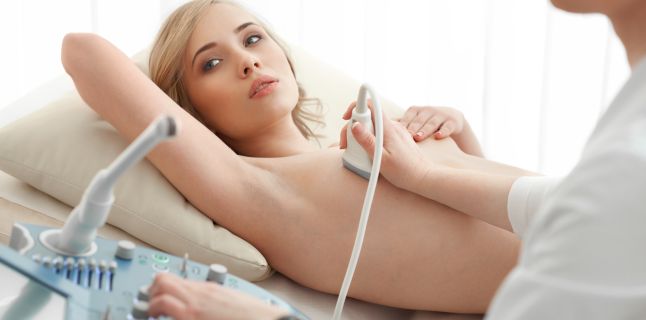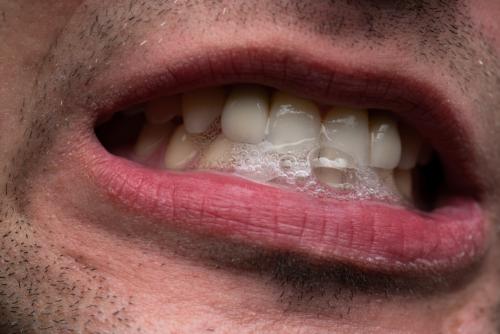Breast fibroadenoma - evolution and complications

Symptoms of breast fibroadenoma are reduced because they are painless and are therefore sometimes discovered by chance either in autopalpation and in a routine check-up such as breast ultrasound or mammography. Their size may vary from 0. 5mm to over 20mm when it can already give a slight feeling of embarrassment in the form of sting and can become painful before menstruation. It is felt to have a round, smooth shape, mobile to the muscular surface of the breast, with a slightly indistinct consistency and can be located in the depth of the breast where it is harder or superficially palpable easy to detect. The diagnosis of the palpation and the discovery is made by the specialist doctor after a mammogram for women over 40 years of age or a mammogram ultrasound for people under the age of 40, where the dimensions. Another important aspect for the correct diagnosis is the evolutionary history of the tumor where the data provided by the patients are essential especially for the changes that have occurred in the last period depending on the shape and appearance of the nodule but also whether or not there were nipple leakage.
In cases where there is a suspicion of diagnosis and the tumor does not need to be extirpated, fine needle biopsy is recommended, a slightly invasive investigation during which a needle is extracted from the nodule with the needle to be sent for histopathological examination. Following the diagnosis, the follow-up steps are established and, in more advanced cases, a treatment is initiated. If we refer to a small nodule or several small nodules, then it will be followed at 3 months, respectively, 6 and 12 months, and if no changes occur, no surgical intervention. If the nodule is large, then the treatment is the surgical procedure in which it is practiced to prevent its evolution. For fibroadenomas that do not regress or change their shape and consistency by the age of 35, surgical excision is preferred.
Also, in patients who have a family history of breast cancer, excision is preferred to avoid their transformation into cancer due to associated genetic risk. Extracted fibroadenoma involves removing the tumor with wide limits of safety from healthy tissue to the tumor to avoid recurrence of other nodules and a periareolar incision to preserve esthetic integrity. This surgery, also known as tumorectomy, is performed under total anesthesia in the case of large and under local anesthesia in the case of small ones. The postinterventional patient will also have a drain tube to avoid the build up of excessive blood in the mammary gland and to drain the debris during surgery. She will be hospitalized for 2-5 days depending on the condition of the patient, then requires daily wound care with local antiseptic solutions (betadine, rivanol) and suture suppression 5-7-10 days after surgery.
After surgery, women of childbearing age who want to get pregnant have the indication to stay behind after a period of six months after surgery to pass the effect of anesthesia and to restore tissue. The benefit of a desired task would be to regulate hormonal functions and even stop the development of fibroadenomas. Alternative treatment would be to approach a balanced lifestyle by reducing coffee intake, a low fat and high-fiber diet, but also an extra intake of vitamin C and vitamin E that have an antioxidant role. It is also recommended to apply warm compresses to the breast during dysmenorrhea, or various natural remedies such as cabbage leaves applied at bedtime, acupuncture and homeopathy with a role in hormone rebalancing. In terms of evolution, they can grow from month to month, reaching the size of the egg, may become painful due to the compression that occurs with the increase in volume, sometimes they can cause problems and aesthetic that lead to the deformation of the breast, more .
Complications are rare and either in compression or post-operative evolution where we refer to bleeding, stinging pain, wound infection, etc. . An essential role in its detection is its autopalpation to be done monthly, preferably on days 5-10 after the installation of the menstrual cycle, in front of the mirror, and should include palpation of the axillary area to detect possible axillary adenopathy with an important role in . For menopausal women it does not matter the day they choose, they can choose any day they want from the moon and with the help of the 3 fingers (middle, and middle finger) they make circular pressure movements with the fingertips all over the breast surface. It is not to be neglected either the mammary aria and the nipple which in some situations can change their shape or color and can provide important information.
.
Source : sfatulmedicului.ro
Views : 2987
Popular Article
- (photo) Nude becomes art.
Posted: 2018-03-17, 9591 views.
- The harmful effects of air conditioning on the skin
Posted: 2017-06-08, 8274 views.
- 3 causes of dyed hair discoloration
Posted: 2017-06-15, 8146 views.
- Why early puberty occurs in girls: symptoms, favors, diagnosis and treatment
Posted: 2017-10-24, 8003 views.
- Good or bad skin treatments in the hot season
Posted: 2017-06-07, 7740 views.
Recommendations
- (photo) Nude becomes art.
Posted: 2018-03-17, 9591 views.
- The harmful effects of air conditioning on the skin
Posted: 2017-06-08, 8274 views.
- 3 causes of dyed hair discoloration
Posted: 2017-06-15, 8146 views.
- Good or bad skin treatments in the hot season
Posted: 2017-06-07, 7740 views.
- Risks of practicing sports on hot days
Posted: 2017-06-12, 7335 views.
 4 effective ingredients in the fight against acne.
4 effective ingredients in the fight against acne. How to get rid of hiccups fast
How to get rid of hiccups fast The wheat bran diet: the secret of lost pounds as if by magic
The wheat bran diet: the secret of lost pounds as if by magic The recipe that will sweeten your soul this weekend!
The recipe that will sweeten your soul this weekend!  Is it dangerous or not to refreeze meat after thawing it?
Is it dangerous or not to refreeze meat after thawing it?  The unusual sign of diabetes indicated by saliva.
The unusual sign of diabetes indicated by saliva. What to drink to boost your immune system.
What to drink to boost your immune system. 10 foods that help you never age.
10 foods that help you never age. What actually happens in your body if you drink a cup of coffee for breakfast
What actually happens in your body if you drink a cup of coffee for breakfast 5 surprising benefits of chia seeds
5 surprising benefits of chia seeds